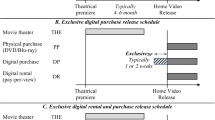Abstract
This research presents a systematic empirical analysis of the market for digital versatile discs (DVDs). We examine a sample of 953 DVD titles that appeared on the weekly top-30 sales charts in North America over a 30-month interval. We find that the size distribution of weekly DVD sales revenue does not indicate the presence of increasing returns to information. The empirical results for DVD sales contrast starkly with previous results obtained for motion-picture box-office revenue, where a number of researchers have found evidence of positive feedback in demand. While the distribution of cumulative revenues across DVDs is highly unequal, the DVD market appears not to be characterized by the extreme heavy upper tail that so well describes the winner-take-all nature of the distribution of box-office success across motion pictures.







Similar content being viewed by others
Notes
Of course there were interesting studies related to the movie business prior to the Smith and Smith (1986) paper—such as Cheung’s (1980) analysis of moral hazard and ticket pricing and Kenney and Klein’s (1983) analysis of exhibitor-distributor contracting practices—but the area has flourished only recently.
A brief account of the analytics of movie demand dynamics—where filmgoers discover the films they like by consuming them and through the exchange of information—is provided in Walls (2008).
The type of approach taken here is discussed at some length by Brock (1999), who argues that empirical regularities in the form of scaling laws, such as the Pareto law, may be useful in providing information on the process that is generating the data. Our use of the Pareto law here is similar to recent work in econophysics (Rosser 2008a, b).
Vining (1976) provides further analysis and refinement of the Ijiri and Simon (1974) analytical framework. Vining’s (1976) insights will become useful in the interpretation of our empirical results, but to focus on the methodological issues raised in his research at this point in this paper would overly complicate the exposition of this section while not adding anything fundamental to the reader’s understanding.
To simplify the prose, I will refer to the normal model where it will be implicit that I am referring to the logarithm of revenue as the random variable of interest.
Because our data set contains only the top thirty DVDs—and not the entire population—we cannot provide an analysis of Anderson’s (2006) long tail hypothesis as is done by Elberse and Olberholzer-Gee (2008). However, our data do permit the estimation of the size–rank distribution as set out in the previous section; even the original De Vany and Walls (1996) analysis was based on the top fifty films as listed in Daily Variety. Estimation of the rank–revenue relationship is not affected by the top-earning products because it is a scale-invariant size distribution.
DVDs may not appear on the chart continuously. That is a DVD on the chart may fall from the chart and re-enter the chart in subsequent weeks. The rank–revenue analysis of cumulative earnings across DVD titles will be unaffected by this. For the weekly analysis, our results are not substantively affected by this.
Before estimating the Pareto law, we first plotted the size distribution of our data for each week of the top-30 sample, a plot of revenue against rank on logarithmic axes. The data appeared to follow the log-linearity implied by the strict Pareto law in Eq. 1 above. At the suggestion of a referee, this figure has been removed from the paper.
The DVD market may have experienced large changes in demand over the span of data analyzed. The weekly dummy variables in the regression analysis control for this possibility; one can think of the weekly dummies as time-specific effects in the model.
References
Acheson, K., & Maule, C. J. (1995). Understanding Hollywood’s organization and continuing success. Journal of Cultural Economics, 18(4), 271–300.
Anderson, C. (2006). The long tail: Why the future of business is selling less of more. New York: Hyperion.
Bikhchandani, S., Hirshleifer, D., & Welch, I. (1992). A theory of fads, fashion, custom, and cultural change as informational cascades. Journal of Political Economy, 100(5), 992–1026.
Blumenthal, M. A. (1988). Auctions with constrained information: Blind bidding for motion pictures. Review of Economics and Statistics, 70(2), 191–198.
Brock, W. A. (1999). Scaling in economics: A reader’s guide. Industrial and Corporate Change, 8(3), 409–446.
Carlton, D. W., & Chevalier, J. A. (2001). Free riding and sales strategies for the internet. Journal of Industrial Economics, 49, 441–461.
Caves, R. E. (2000). Creative industries: Contracts between art and commerce. Cambridge: Harvard University Press.
Cheung, S. N. S. (1980). Rose Bowl vs. Hong Kong: The economics of seat pricing. Research in Law and Economics, (Supplement 1), 27–43.
Chisholm, D., & Norman, G. (2004). Heterogeneous preferences and location choice with multi-product firms. Regional Science and Urban Economics, 34(3), 321–339.
Chisholm, D. C. (1993). Asset specificity and long-term contracts: The case of the motion-pictures industry. Eastern Economic Journal, 19(2), 143–155.
Davis, P. (2006a). Measuring the business stealing, cannabilization and market expansion effects of entry in the U.S. motion picture exhibition market. Journal of Industrial Economics, 54, 293–321.
Davis, P. (2006b). Spatial competition in retail markets: Movie theaters. Rand Journal of Economics, 37, 964–982.
De Vany, A. S., & Eckert, R. (1991). Motion picture antitrust: The paramount cases revisited. Research in Law and Economics, 14, 51–112.
De Vany, A. S., & Lee, C. (2001). Quality signals in information cascades and the dynamics of the distribution of motion picture box office revenues. Journal of Economic Dynamics and Control, 25(3–4), 593–614.
De Vany, A. S., & McMillan, H. (2004). Was the antitrust action that broke up the movie studios good for the movies? Evidence from the stock market. American Law and Economics Review, 6(1), 135–153.
De Vany, A. S., & Walls, W. D. (1996). Bose–Einstein dynamics and adaptive contracting in the motion picture industry. The Economic Journal, 439(106), 1493–1514.
De Vany, A. S., & Walls, W. D. (1999). Uncertainty in the movie industry: Does star power reduce the terror of the box office? Journal of Cultural Economics, 23(4), 285–318.
De Vany, A. S., & Walls, W. D. (2002). Does Hollywood make too many R-rated movies?: Risk, stochastic dominance, and the illusion of expectation. Journal of Business, 75(3), 425–451.
De Vany, A. S., & Walls, W. D. (2004). Motion picture profit, the stable Paretian hypothesis, and the curse of the superstar. Journal of Economic Dynamics and Control, 28(6), 1035–1057.
Einav, L. (2007). Seasonality in the US motion picture industry. Rand Journal of Economics, 38(1), 127–145.
Elberse, A., & Olberholzer-Gee, F. (2008). Superstars and underdogs: An examination of the long-tail phenomenon in video sales. Harvard Business School Working Paper Series.
Fee, E. (2002). The costs of outside equity control: Evidence from motion picture financing decisions. Journal of Business, 75(4), 681–711.
Frank, B. (1994). Optimal timing of movie releases in ancillary markets: The case of video releases. Journal of Cultural Economics, 18, 125–133.
Gaffeo, E., Scorcu, A. E., & Vici, L. (2006). Demand distribution dynamics in the book publishing industry. Paper presented at the WEHIA Conference, Bologna.
Giles, D. E. (2007). Increasing returns to information in the US popular music industry. Applied Economics Letters, 14(5–6), 327–331.
Goettler, R. L., & Leslie, P. (2005). Cofinancing to manage risk in the motion picture industry. Journal of Economics and Management Strategy, 14(2), 231–261.
Goldman, W. (1983). Adventures in the screen trade. New York: Warner Books.
Hand, C. (2001). Increasing returns to information: Further evidence from the UK film market. Applied Economics Letters, 8(6), 419–421.
Hanssen, A. F. (2002). Revenue sharing in movie exhibition and the coming of sound. Economic Inquiry, 40, 380–402.
Ho, J., Ho, K., & Mortimer, J. (2008). Welfare effects of full-line forcing contracts in the video rental industry. Harvard Business School working paper.
Ijiri, Y., & Simon, H. A. (1974). Interpretations of departures from the Pareto curve firm-size distributions. Journal of Political Economy, 82(2), 315–332.
Jozefowicz, J. J., Kelley, J. M., & Brewer, S. M. (2008). New release: An empirical analysis of VHS/DVD rental success. Atlantic Economic Journal, 36, 139–151.
Kenney, R. W., & Klein, B. (1983). The economics of block booking. Journal of Law and Economics, 26, 497–540.
Maddison, D. (2004). Increasing returns to information and the survival of Broadway theatre productions. Applied Economics Letters, 11(10), 639–643.
Mahajan, V., Muller, E., & Kerin, R. A. (1984). Introduction strategy for new products with positive and negative word-of-mouth. Management Science, 30(12), 1389–1404.
McCulloch, J. H. (1986). Simple consistent estimators of stable distribution parameters. Communications in Statistics: Simulation and Computation, 15, 1109–1136.
Mizerski, R. W. (1982). An attribution explanation of the disproportionate influence of unfavorable information. Journal of Consumer Research, 9, 301–310.
Mortimer, J. H. (2007). Price discrimination, copyright law, and technological innovation: Evidence from the introduction of DVDs. Quarterly Journal of Economics, 122, 1307–1350.
Motion Picture Association of America (2007). Entertainment industry market statistics.
Moul, C. (2001). Evidence of qualitative learning-by-doing from the advent of the talkie. Journal of Industrial Economics, 49(1), 97–109.
Moul, C. (2007). Measuring word-of-mouth’s impact on theatrical movie admissions. Journal of Economics and Management Strategy, 16(4), 859–892.
Nelson, R. A., Reid, C. E., & Gilmore, O. (2007). An analysis of the out-of-market gap for DVDs in the U.S. Review of Industrial Organization, 30, 303–323.
Nolan, J. P. (2001). Maximum likelihood estimation of stable parameters. In O. E. Barndor-Nielsen, T. Mikosch, & S. I. Resnick (Eds.), Lévy processes: Theory and applications (pp. 379–400). Boston: Birkhäuser.
Nolan, J. P. (2005). STABLE computer program. Available for download at http://www.academic2.american.edu/~jpnolan/stable/stable.html.
Orbach, B. Y., & Einav, L. (2007). Uniform prices for differentiated goods: The case of the movie-theatre industry. International Review of Law and Economics, 27, 129–153.
Palia, D., Ravid, S. A., & Reisel, N. (2008). Choosing to co-finance: An analysis of project-specific alliances in the movie industry. Review of Financial Studies, 21(2), 483–511.
Ravid, S. A. (1999). Information, blockbusters and stars: A study of the film industry. Journal of Business, 72, 463–486.
Rosen, S. (1981). The economics of superstars. American Economic Review, 71, 167–183.
Rosen, S., & Rosenfield, A. M. (1997). Ticket pricing. Journal of Law and Economics, 40(2), 351–76.
Rosser, J. B., Jr. (2008a). Econophysics. In S. N. Durlauf, & L. E. Blume (Eds.), The new Palgrave dictionary of economics (2nd ed.). Basingstoke: Palgrave Macmillan.
Rosser, J. B., Jr. (2008b). Power laws. In S. N. Durlauf, & L. E. Blume (Eds.), The new Palgrave dictionary of economics (2nd ed.). Basingstoke: Palgrave Macmillan.
Rusco, F. W., & Walls, W. D. (2004). Independent film finance, pre-sale agreements, and the distribution of film earnings. In V. Ginsburgh (Ed.), The economics of art and culture, Contributions to Economic Analysis No. 260, Chap. 2 (pp. 19–32). Amsterdam: Elsevier.
Simon, H. A. (1955). On a class of skew distribution functions. Biometrica, 52, 425–440.
Smith, S. P., & Smith, V. K. (1986). Successful movies: A preliminary empirical analysis. Applied Economics, 18(5), 501–507.
Srivastava, D., & Mittal, A. (1987). On the economics of entertainment: Optimal length of movie runs. Indian Economic Journal, 35(1), 66–82.
Steindl, J. (1965). Random processes and the growth of firms: A study of the Pareto law. New York: Hafner.
Varian, H. R. (1992). Microeconomic analysis (3rd ed.). New York: Norton.
Vining, D. (1976). Autocorrelated growth rates and the Pareto law: A further analysis. Journal of Political Economy, 84(2), 369–380.
Walls, W. D. (1997). Increasing returns to information: Evidence from the Hong Kong movie market. Applied Economics Letters, 4(5), 187–190.
Walls, W. D. (2005a). Demand stochastics, supply adaptation, and the distribution of film earnings. Applied Economics Letters, 12(10), 619–623.
Walls, W. D. (2005b). Modeling skewness and heavy tails in film returns. Applied Financial Economics, 15(17), 1181–1188.
Walls, W. D. (2008). Economics of motion pictures. In S. N. Durlauf, & L. E. Blume (Eds.), The new Palgrave dictionary of economics (2nd ed., Vol. 5, pp. 787–791). Basingstoke: Palgrave Macmillan.
Author information
Authors and Affiliations
Corresponding author
Rights and permissions
About this article
Cite this article
Walls, W.D. Superstars and heavy tails in recorded entertainment: empirical analysis of the market for DVDs. J Cult Econ 34, 261–279 (2010). https://doi.org/10.1007/s10824-010-9125-z
Received:
Accepted:
Published:
Issue Date:
DOI: https://doi.org/10.1007/s10824-010-9125-z




